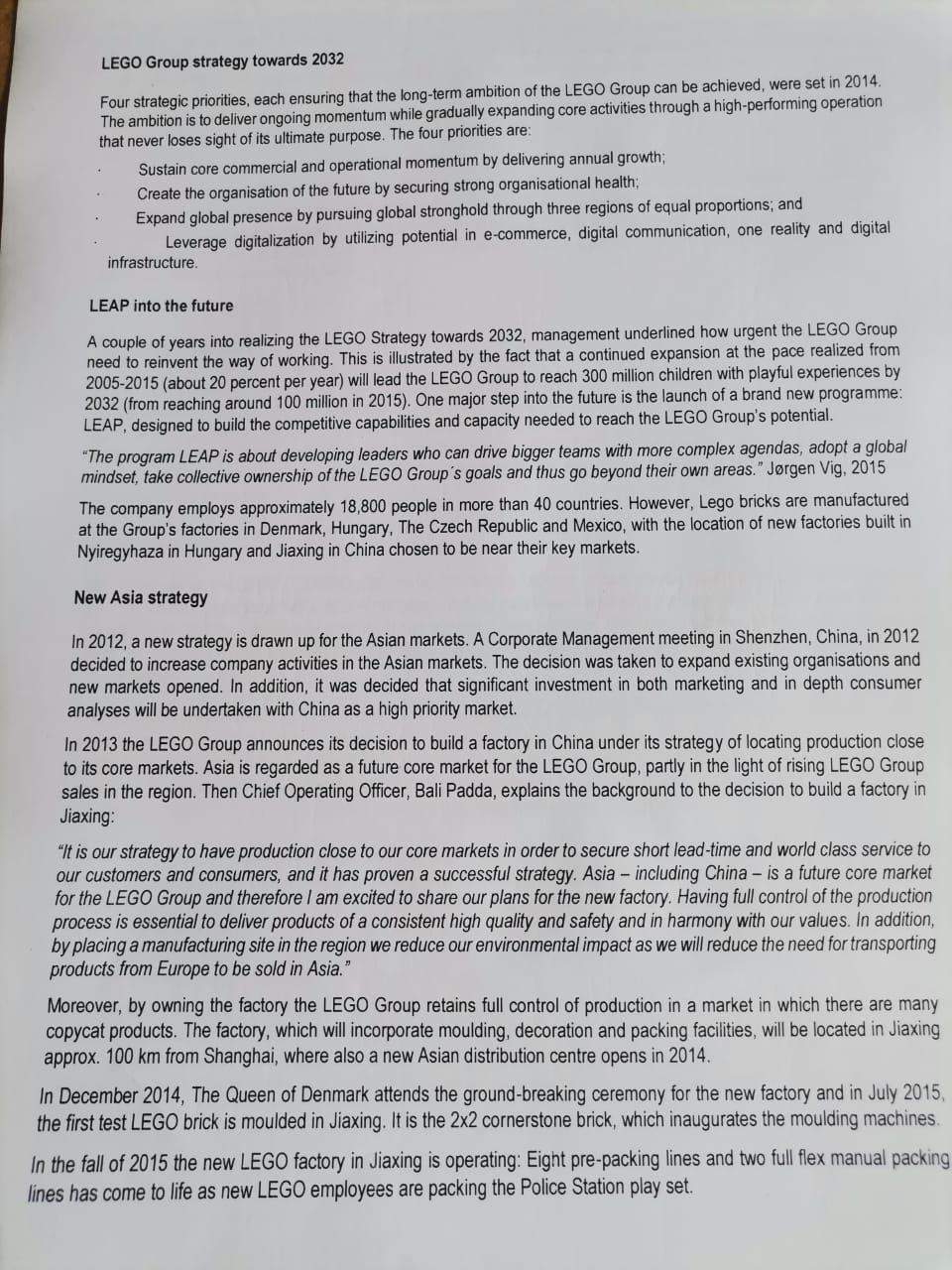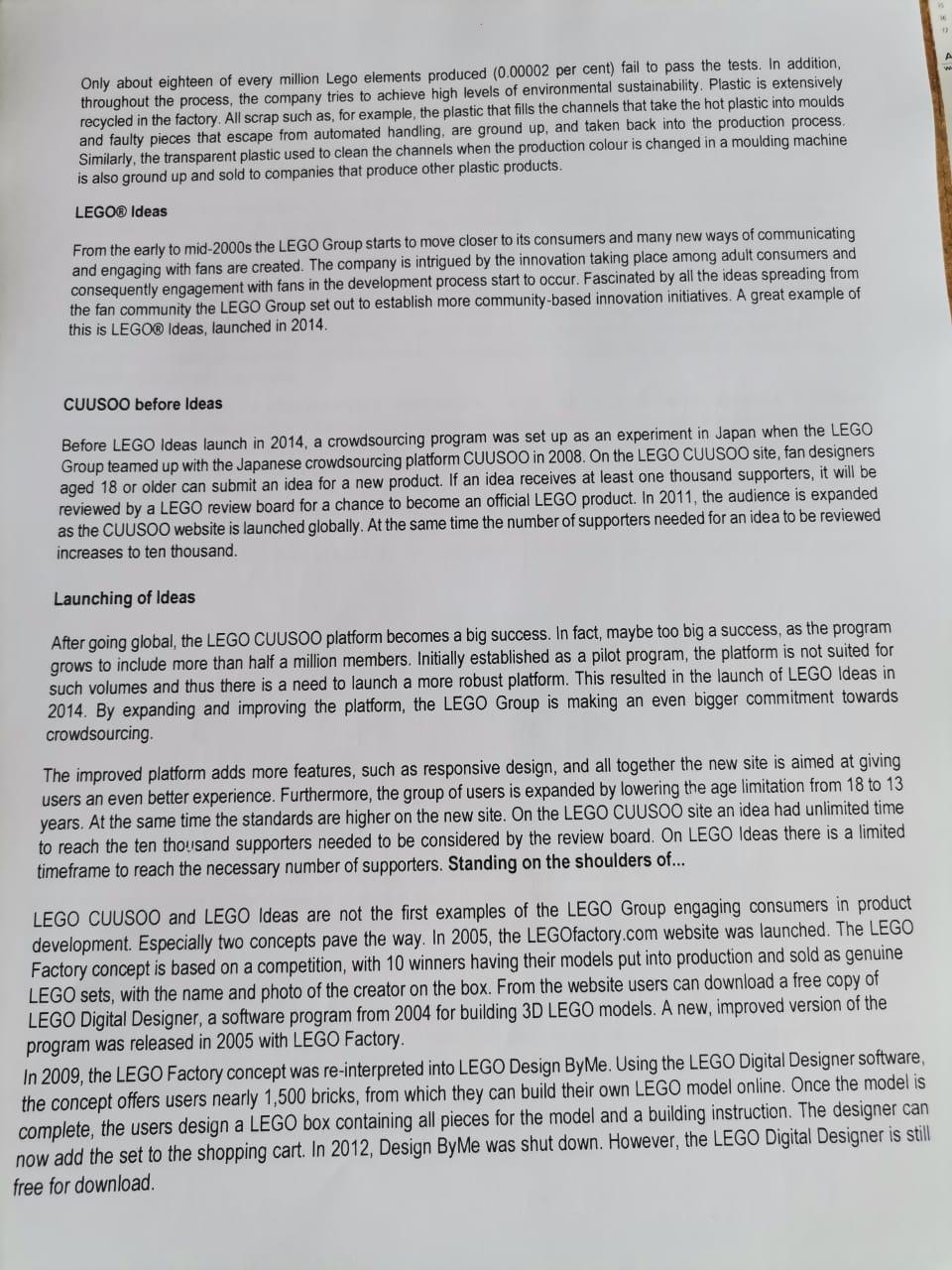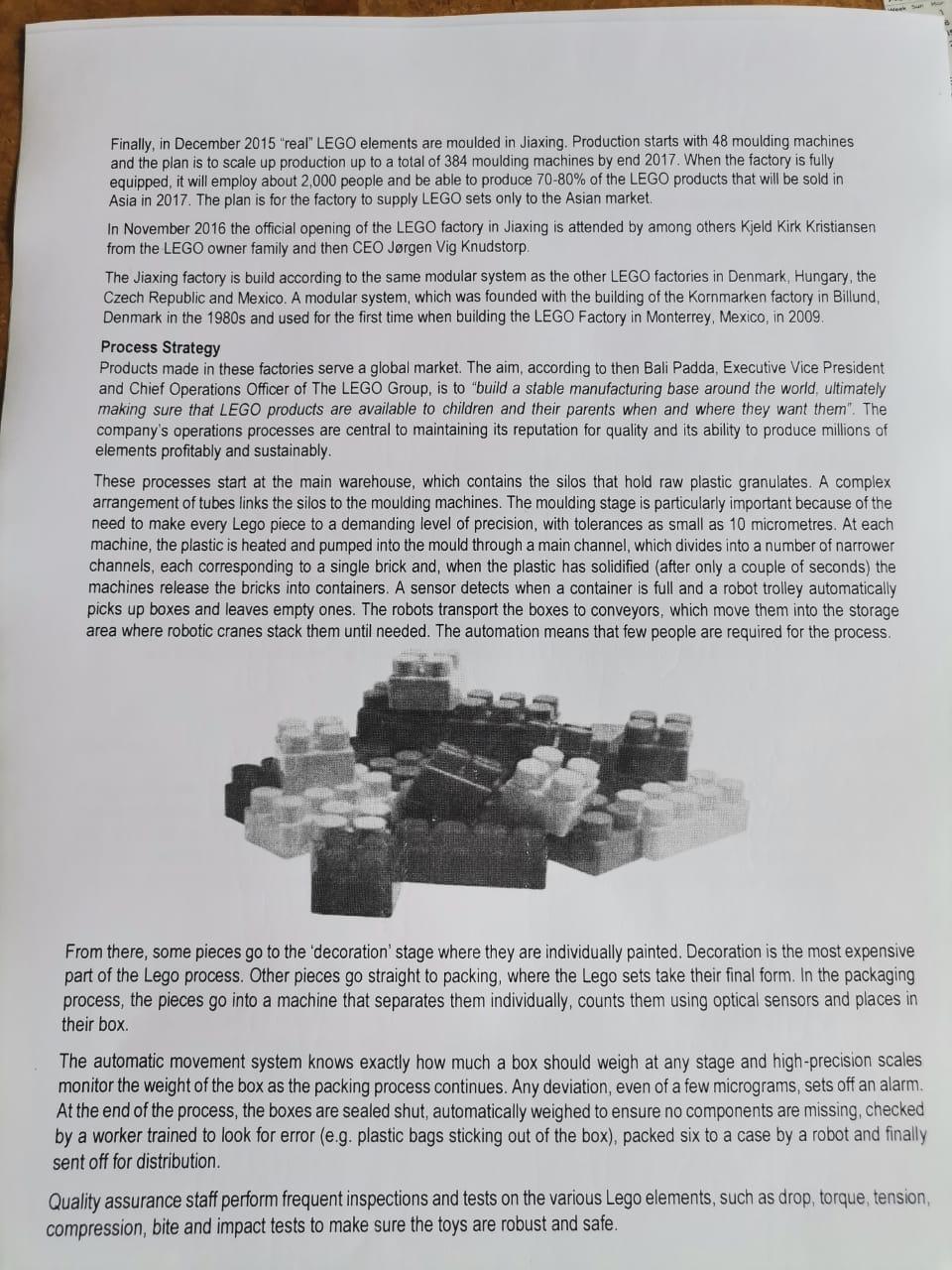





Read the case study on Lego below and answer all questions that follow. The LEGO Group Of all business, the toy business is one of the world's trickiest. It is difficult to forecast, unfailingly subject to fickle kids latest fads and subject to constant technological innovation. Yet, in recent years, The LEGO Group, a privately held, familyowned company with headquarters in Billund, Denmark, has survived in the business, becoming one of the most reputable companies in the world, according to the Reputation Institute, and one of the leading manufacturers of play materials. It is a success founded on a deceptively simple idea. The name 'LEGO' is an abbreviation of the two Danish word "leg godt", meaning "play well". It is the name as well as the ideal of the company. The LEGO Group was founded in 1932 by Ole Kirk Kristiansen and based on the iconic LEGO brick. It is one of the world's leading manufacturers of play materials. The company has passed from father to son and is now owned by Kjeld Kirk Kristiansen, a grandchild of the founder. It has come a long way over the past almost 85 years - from a small carpenter's workshop to a modern, global enterprise that is now one of the world's largest manufacturers of toys. The LEGO brick is the company's most important invention The products of the company have undergone extensive development over the years - but the foundation remains the traditional LEGO brick. The brick in its present form was launched in 1958. The interlocking principle with its tubes makes it unique and offers unlimited building possibilities. It is just a matter of getting the imagination going - and letting a wealth of creative ideas emerge through play. The company is proud to have been named "Toy of the Century" twice. One Lego brick is remarkable, but one or two together and possibilities start to emerge. With another few bricks, the number of things you can create rises exponentially. There are more than 915 million possible ways of arranging six standard four by two bricks; and, however many bricks you assemble, irrespective of what colour or set they are from your pieces will always fit together perfectly. All of the basic Lego elements use the same method to stick together. They have studs on top and tubes on the inside. The bricks studs are slightly bigger than the space between the tubes and the walls. Pressing the bricks together produces an 'interference fit" that provides a temporary joint without the use of an additional fastener. However, this principle does depend on very high levels of precision and quality in the manufacture of the elements, which explains the company's motto, "only the best is good enough". LEGO Group strategy towards 2032 Four strategic priorities, each ensuring that the long-term ambition of the LEGO Group can be achieved, were set in 2014. The ambition is to deliver ongoing momentum while gradually expanding core activities through a high-performing operation that never loses sight of its ultimate purpose. The four priorities are: Sustain core commercial and operational momentum by delivering annual growth; Create the organisation of the future by securing strong organisational health: Expand global presence by pursuing global stronghold through three regions of equal proportions; and Leverage digitalization by utilizing potential in e-commerce, digital communication, one reality and digital infrastructure. LEAP into the future A couple of years into realizing the LEGO Strategy towards 2032, management underlined how urgent the LEGO Group need to reinvent the way of working. This is illustrated by the fact that a continued expansion at the pace realized from 2005-2015 (about 20 percent per year) will lead the LEGO Group to reach 300 million children with playful experiences by 2032 (from reaching around 100 million in 2015). One major step into the future is the launch of a brand new programme: LEAP, designed to build the competitive capabilities and capacity needed to reach the LEGO Group's potential. "The program LEAP is about developing leaders who can drive bigger teams with more complex agendas, adopt a global mindset, take collective ownership of the LEGO Group's goals and thus go beyond their own areas." Jrgen Vig, 2015 The company employs approximately 18,800 people in more than 40 countries. However, Lego bricks are manufactured at the Group's factories in Denmark, Hungary, The Czech Republic and Mexico, with the location of new factories built in Nyiregyhaza in Hungary and Jiaxing in China chosen to be near their key markets. New Asia strategy In 2012, a new strategy is drawn up for the Asian markets. A Corporate Management meeting in Shenzhen, China, in 2012 decided to increase company activities in the Asian markets. The decision was taken to expand existing organisations and new markets opened. In addition, it was decided that significant investment in both marketing and in depth consumer analyses will be undertaken with China as a high priority market. In 2013 the LEGO Group announces its decision to build a factory in China under its strategy of locating production close to its core markets. Asia is regarded as a future core market for the LEGO Group, partly in the light of rising LEGO Group sales in the region. Then Chief Operating Officer, Bali Padda, explains the background to the decision to build a factory in Jiaxing: "It is our strategy to have production close to our core markets in order to secure short lead-time and world class service to our customers and consumers, and it has proven a successful strategy. Asia - including China - is a future core market for the LEGO Group and therefore I am excited to share our plans for the new factory. Having full control of the production process is essential to deliver products of a consistent high quality and safety and in harmony with our values. In addition, by placing a manufacturing site in the region we reduce our environmental impact as we will reduce the need for transporting products from Europe to be sold in Asia." Moreover, by owning the factory the LEGO Group retains full control of production in a market in which there are many copycat products. The factory, which will incorporate moulding, decoration and packing facilities will be located in Jiaxing approx. 100 km from Shanghai, where also a new Asian distribution centre opens in 2014. In December 2014, The Queen of Denmark attends the ground-breaking ceremony for the new factory and in July 2015, the first test LEGO brick is moulded in Jiaxing. It is the 2x2 cornerstone brick, which inaugurates the moulding machines In the fall of 2015 the new LEGO factory in Jiaxing is operating: Eight pre-packing lines and two full flex manual packing lines has come to life as new LEGO employees are packing the Police Station play set. Only about eighteen of every million Lego elements produced (0.00002 per cent) fail to pass the tests. In addition, throughout the process, the company tries to achieve high levels of environmental sustainability. Plastic is extensively recycled in the factory. All scrap such as, for example, the plastic that fills the channels that take the hot plastic into moulds and faulty pieces that escape from automated handling, are ground up, and taken back into the production process. Similarly, the transparent plastic used to clean the channels when the production colour is changed in a moulding machine is also ground up and sold to companies that produce other plastic products. LEGO Ideas From the early to mid-2000s the LEGO Group starts to move closer to its consumers and many new ways of communicating and engaging with fans are created. The company is intrigued by the innovation taking place among adult consumers and consequently engagement with fans in the development process start to occur. Fascinated by all the ideas spreading from the fan community the LEGO Group set out to establish more community-based innovation initiatives. A great example of this is LEGO Ideas, launched in 2014. CUUSOO before Ideas Before LEGO Ideas launch in 2014, a crowdsourcing program was set up as an experiment in Japan when the LEGO Group teamed up with the Japanese crowdsourcing platform CUUSOO in 2008. On the LEGO CUUSOO site, fan designers aged 18 or older can submit an idea for a new product. If an idea receives at least one thousand supporters, it will be reviewed by a LEGO review board for a chance to become an official LEGO product. In 2011, the audience is expanded as the CUUSOO website is launched globally. At the same time the number of supporters needed for an idea to be reviewed increases to ten thousand. Launching of Ideas After going global, the LEGO CUUSOO platform becomes a big success. In fact, maybe too big a success, as the program grows to include more than half a million members. Initially established as a pilot program, the platform is not suited for such volumes and thus there is a need to launch a more robust platform. This resulted in the launch of LEGO Ideas in 2014. By expanding and improving the platform, the LEGO Group is making an even bigger commitment towards crowdsourcing The improved platform adds more features, such as responsive design, and all together the new site is aimed at giving users an even better experience. Furthermore, the group of users is expanded by lowering the age limitation from 18 to 13 years. At the same time the standards are higher on the new site. On the LEGO CUUSOO site an idea had unlimited time to reach the ten thousand supporters needed to be considered by the review board. On LEGO Ideas there is a limited timeframe to reach the necessary number of supporters. Standing on the shoulders of... LEGO CUUSOO and LEGO Ideas are not the first examples of the LEGO Group engaging consumers in product development. Especially two concepts pave the way. In 2005, the LEGOfactory.com website was launched. The LEGO Factory concept is based on a competition, with 10 winners having their models put into production and sold as genuine LEGO sets, with the name and photo of the creator on the box. From the website users can download a free copy of LEGO Digital Designer, a software program from 2004 for building 3D LEGO models. A new, improved version of the program was released in 2005 with LEGO Factory In 2009, the LEGO Factory concept was re-interpreted into LEGO Design ByMe. Using the LEGO Digital Designer software, the concept offers users nearly 1,500 bricks, from which they can build their own LEGO model online. Once the model is complete, the users design a LEGO box containing all pieces for the model and a building instruction. The designer can now add the set to the shopping cart. In 2012, Design ByMe was shut down. However, the LEGO Digital Designer is still free for download. Finally, in December 2015 "real" LEGO elements are moulded in Jiaxing. Production starts with 48 moulding machines and the plan is to scale up production up to a total of 384 moulding machines by end 2017. When the factory is fully equipped, it will employ about 2,000 people and be able to produce 70-80% of the LEGO products that will be sold in Asia in 2017. The plan is for the factory to supply LEGO sets only to the Asian market. In November 2016 the official opening of the LEGO factory in Jiaxing is attended by among others Kjeld Kirk Kristiansen from the LEGO owner family and then CEO Jrgen Vig Knudstorp, The Jiaxing factory is build according to the same modular system as the other LEGO factories in Denmark, Hungary, the Czech Republic and Mexico. A modular system, which was founded with the building of the Kornmarken factory in Billund, Denmark in the 1980s and used for the first time when building the LEGO Factory in Monterrey, Mexico, in 2009. Process Strategy Products made in these factories serve a global market. The aim, according to then Bali Padda, Executive Vice President and Chief Operations Officer of The LEGO Group, is to build a stable manufacturing base around the world, ultimately making sure that LEGO products are available to children and their parents when and where they want them". The company's operations processes are central to maintaining its reputation for quality and its ability to produce millions of elements profitably and sustainably. These processes start at the main warehouse, which contains the silos that hold raw plastic granulates. A complex arrangement of tubes links the silos to the moulding machines. The moulding stage is particularly important because of the need to make every Lego piece to a demanding level of precision, with tolerances as small as 10 micrometres. At each machine, the plastic is heated and pumped into the mould through a main channel, which divides into a number of narrower channels, each corresponding to a single brick and when the plastic has solidified (after only a couple of seconds) the machines release the bricks into containers. A sensor detects when a container is full and a robot trolley automatically picks up boxes and leaves empty ones. The robots transport the boxes to conveyors, which move them into the storage area where robotic cranes stack them until needed. The automation means that few people are required for the process. From there, some pieces go to the 'decoration stage where they are individually painted. Decoration is the most expensive part of the Lego process. Other pieces go straight to packing, where the Lego sets take their final form. In the packaging process, the pieces go into a machine that separates them individually, counts them using optical sensors and places in their box. The automatic movement system knows exactly how much a box should weigh at any stage and high-precision scales monitor the weight of the box as the packing process continues. Any deviation, even of a few micrograms, sets off an alarm. At the end of the process, the boxes are sealed shut, automatically weighed to ensure no components are missing, checked by a worker trained to look for error (e.g. plastic bags sticking out of the box), packed six to a case by a robot and finally sent off for distribution. Quality assurance staff perform frequent inspections and tests on the various Lego elements, such as drop, torque tension, compression, bite and impact tests to make sure the toys are robust and safe. Crowdsourcing at its finest The LEGO Group sees great potential in crowdsourcing in large part due to the LEGO brick. In the words of Tormod Askildsen, Head of AFOL Engagement "The LEGO brick is a language to express ideas and tell stories, and there are billions of ideas to be shared and stories to be told". Today the LEGO Ideas website helps realize exactly this through the amazing creativity of fan designers. Source:https://www.lego.com/en-us/lego-history Question 1 (20 Marks) Using appropriate academic sources and supporting evidence from the LEGO Group case study above, answer the questions below. 1.1 (8 marks) 1.2 One of the four strategic priorities of the Lego Group is to "expand global presence by pursuing global stronghold through three regions of equal proportions". In this regard, discuss any SIX (6) factors motivating the internationalisation of the LEGO Group's operations. Your discussion should include an appropriate introduction and conclusion. With the aid of an appropriately labelled 'Input-Transformation-Output' diagram drawn using information from the LEGO case study, comprehensively discuss the essential elements of the transformation process underpinning the operations of the LEGO Group. In your discussion, specify the transformed and transforming resources involved in the operations, and highlight the output and the feedback processes of the LEGO Group's operations. (12 marks)












